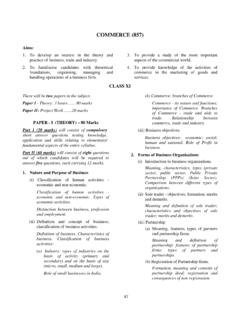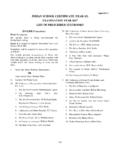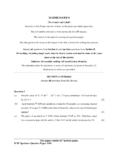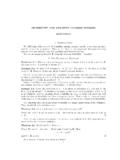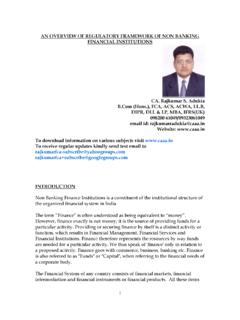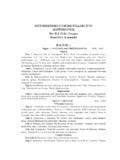Transcription of MATHEMATICS (860) Aims - CISCE
1 121 MATHEMATICS (860) Aims: 1. To enable candidates to acquire knowledge and to develop an understanding of the terms, concepts, symbols, definitions, principles, processes and formulae of MATHEMATICS at the Senior Secondary stage. 2. To develop the ability to apply the knowledge and understanding of MATHEMATICS to unfamiliar situations or to new problems. 3. To develop an interest in MATHEMATICS . 4. To enhance ability of analytical and rational thinking in young minds. 5. To develop skills of - (a) Computation. (b) Logical thinking. (c) Handling abstractions. (d) Generalizing patterns. (e) Solving problems using multiple methods. (f) Reading tables, charts, graphs, etc. 6. To develop an appreciation of the role of MATHEMATICS in day-to-day life.
2 7. To develop a scientific attitude through the study of MATHEMATICS . A knowledge of Arithmetic, Basic Algebra (Formulae, Factorization etc.), Basic Trigonometry and Pure Geometry is assumed. As regards to the standard of algebraic manipulation, students should be taught: (i) To check every step before proceeding to the next particularly where minus signs are involved. (ii) To attack simplification piecemeal rather than en block. (iii) To observe and act on any special features of algebraic form that may be obviously present. 122 CLASS XI The syllabus is divided into three sections A, B and C. Section A is compulsory for all candidates. Candidates will have a choice of attempting questions from EITHER Section B OR Section C.
3 There will be one paper of three hours duration of 100 marks. Section A (80 Marks): Candidates will be required to attempt all questions. Internal choice will be provided in three questions of four marks each and two questions of six marks each. Section B/ Section C (20 Marks): Candidates will be required to attempt all questions EITHER from Section B or Section C. Internal choice will be provided in two questions of four marks each. UNIT TOTAL WEIGHTAGE SECTION A: 80 Marks 1. Sets and Functions 22 Marks 2. Algebra 34 Marks 3. Coordinate Geometry 8 Marks 4. Calculus 8 Marks 5. Statistics & Probability 8 Marks SECTION B: 20 marks 6. Conic Section 12 Marks 7. Introduction to Three Dimensional Geometry 4 Marks 8. Mathematical Reasoning 4 Marks OR SECTION C: 20 Marks 9.
4 Statistics 6 Marks 10. Correlation Analysis 6 Marks 11. Index Numbers & Moving Averages 8 Marks Total 100 Marks 123 SECTION A 1. Sets and Functions (i) Sets Sets and their representations. Empty set. Finite and Infinite sets. Equal sets. Subsets. Subsets of a set of real numbers especially intervals (with notations). Power set. Universal set. Venn diagrams. Union and Intersection of sets. Practical problems on union and intersection of two and three sets. Difference of sets. Complement of a set. Properties of Complement of Sets. (ii) Relations & Functions Ordered pairs, Cartesian product of sets. Number of elements in the cartesian product of two finite sets.
5 Cartesian product of the set of reals with itself (upto R x R x R). Definition of relation, pictorial diagrams, domain, co-domain and range of a relation. Function as a special type of relation. Function as a type of mapping, types of functions (one to one, many to one, onto, into) domain, co-domain and range of a function. Real valued functions, domain and range of these functions, constant, identity, polynomial, rational, modulus, signum, exponential, logarithmic and greatest integer functions, with their graphs. Sum, difference, product and quotient of functions. Sets: Self-explanatory. Basic concepts of Relations and Functions - Ordered pairs, sets of ordered pairs. - Cartesian Product (Cross) of two sets, cardinal number of a cross product. Relations as: - an association between two sets. - a subset of a Cross Product.
6 - Domain, Range and Co-domain of a Relation. - Functions: - As special relations, concept of writing y is a function of x as y = f(x). - Introduction of Types: one to one, many to one, into, onto. - Domain and range of a function. - Sketches of graphs of exponential function, logarithmic function, modulus function, step function and rational function. (iii) Trigonometry Positive and negative angles. Measuring angles in radians and in degrees and conversion from one measure to another. Definition of trigonometric functions with the help of unit circle. Truth of the identity sin2x+cos2x=1, for all x. Signs of trigonometric functions. Domain and range of trignometric functions and their graphs. Expressing sin (x y) and cos (x y) in terms of sinx, siny, cosx & cosy and their simple applications.
7 Deducing the identities like the following: tan (x y) = tantan1 tan tanxyxy , cot(x y)=cot cot1coty cotxxy sin sin =2sin12( )cos12 ( ) cos + cos = 2 cos 12( + ) cos 12 ( - ) cos - cos = - 2sin12 ( + ) sin 12 ( - ) Identities related to sin 2x, cos2x, tan 2x, sin3x, cos3x and tan3x. General solution of trigonometric equations of the type siny = sina, cosy = cosa and tany = tana. Properties of triangles (proof and simple applications of sine rule cosine rule and area of triangle). Angles and Arc lengths - Angles: Convention of sign of angles. - Magnitude of an angle: Measures of Angles; Circular measure. - The relation S = r where is in radians. Relation between radians and degree. 124 - Definition of trigonometric functions with the help of unit circle.
8 - Truth of the identity sin2x+cos2x=1 - NOTE: Questions on the area of a sector of a circle are required to be covered. Trigonometric Functions - Relationship between trigonometric functions. - Proving simple identities. - Signs of trigonometric functions. - Domain and range of the trigonometric functions. - Trigonometric functions of all angles. - Periods of trigonometric functions. - Graphs of simple trigonometric functions (only sketches). NOTE: Graphs of sin x, cos x, tan x, sec x, cosec x and cot x are to be included. Compound and multiple angles - Addition and subtraction formula: sin(A B); cos(A B); tan(A B); tan(A + B + C) etc., Double angle, triple angle, half angle and one third angle formula as special cases. - Sum and differences as products sinC + sinD = 2 22 CDCD sincos+ , etc.
9 - Product to sum or difference 2sinAcosB = sin(A + B) + sin(A B) etc. Trigonometric Equations - Solution of trigonometric equations (General solution and solution in the specified range). - Equations expressible in terms of sin =0 etc. - Equations expressible in terms sin = sin etc. - Equations expressible multiple and sub- multiple angles sin2 = sin2 etc. - Linear equations of the form acos + bsin = c, where 22bac+ and a, b 0 - Properties of Sine formula: ;sinsinsinabcABC== Cosine formula: 22 2cos,2bcaAetcbc+ = Area of triangle: 1 sin ,2bcA etc = Simple applications of the above. 2. Algebra (i) Principle of Mathematical Induction Process of the proof by induction, motivating the application of the method by looking at natural numbers as the least inductive subset of real numbers.
10 The principle of mathematical induction and simple applications. Using induction to prove various summations, divisibility and inequalities of algebraic expressions only. (ii) Complex Numbers Introduction of complex numbers and their representation, Algebraic properties of complex numbers. Argand plane and polar representation of complex numbers. Square root of a complex number. Cube root of unity. - Conjugate, modulus and argument of complex numbers and their properties. - Sum, difference, product and quotient of two complex numbers additive and multiplicative inverse of a complex number. 125 - Locus questions on complex numbers.




